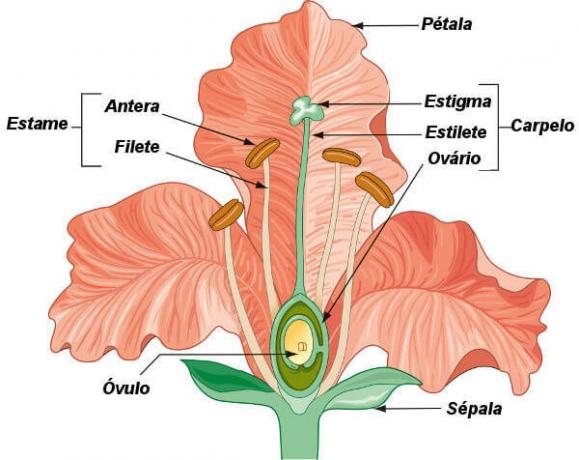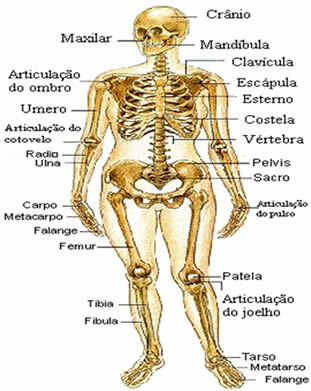Angiosperms are plants that are characterized by presenting flower and fruit. This plant group is the one with the greatest diversity of species, with an estimated total of more than 450,000 different species. Among examples of angiosperms, we can mention: rose bushes, mango trees, rice plants, beans, grasses, lilies, orchids, coconut trees, among many others.
→ Characteristics of angiosperms
Angiosperms are vascular plants (they have conducting vessels) with seeds that have the most striking characteristic of presence of flowers and fruits. The term angiosperm comes from the Greek angel, which means urn, and sperma, which means seed. Analyzing its name, we can conclude, therefore, that it is related to one of its exclusive characteristics: the presence of fruit surrounding the seed.
You fruits are formed from the development of the ovary of the flowers after the fertilization process. They are important for the success of this group of plants, as they act to protect the seed and help disperse these structures.
Do not stop now... There's more after the advertising ;)
Read too:Seed Dispersers
In addition to the fruits, the flowers were important to ensure that the angiosperms became the group of plants with the highest number of representatives. This structure, which will be discussed further below, is related to the pollination process. Showy flowers that release odors are essential to ensure the attraction of pollinators.
→ Life cycle of angiosperms

The life cycle of angiosperms is complex and involves the process of double fertilization.
The life cycle of angiosperms is complex when compared to other plant groups. We will start this cycle through the process of pollination, that is, the moment when the transfer of pollen produced in the anther to the stigma occurs.
When pollen grain is released into the anther, it has a vegetative cell and a generative cell, which divide and form the two male gametes (sperm nuclei). The vegetative cell will be responsible for the formation of the pollen tube, which will ensure the transfer of gametes to the female part of the flower.
The mature female gametophyte of an angiosperm is called embryo sac. In it, seven cells are usually found, which have eight nuclei. These seven cells are the oosphere (female gamete), two synergides, three antipodes, and a central cell with two nuclei.
The pollen grain, upon reaching the stigma of the flower, germinates and produces the pollen tube, which grows by the stylet until reaching the ovary, penetrates the egg through the micropyle (opening of the egg) and finds the sac embryonic.
At the time of fertilization, the two male gametes will act (double fertilization). One joins the oosphere, producing the embryo, and the other joins the two polar nuclei, forming the endosperm, a triploid structure. This endosperm will provide nutrients to the embryo during development.
Read too:double fertilization
The embryo develops and the egg's integuments give rise to the sheaths of the seed. The flower's ovary then develops into fruit. If the seed finds a suitable place for its germination, it will originate a new individual (sporophyte).
→ flower
The flower is an extremely important structure for angiosperms, and this structure is a highly modified branch that grows for a limited time. One flower has sterile parts and reproductive parts, which emerge in the receptacle (dilated region).

Look carefully at the parts of the flower.
The sterile appendices are the petals and the sepals. Generally, the sepals are green in color, and the petals are varied in color, often showy. The set of sepals of a flower form a Cup, while the set of petals forms the corolla. Sepals and petals together form perianth.
We also have the reproductive parts: stamens and carpels. You stamens they are the portion of the plant where pollen is produced. The stamen is formed by fillet and for anther, the latter being the place where pollen is produced. The set of stamens forms the androce.
O carpel it is the part of the flower where the eggs are. Each carpel has three basic parts: the stigma, the stylet and the ovary. The stigma is where the pollen grain is deposited, the stylet is where the pollen tube grows, and the ovary is where the eggs are. The set of carpels forms the gyneceous.
→ Fruit

Lemon is a fruit of the lemon tree.
Fruits are formed from the development of the ovary after the fertilization process. In some cases, tissues other than the ovary develop and form fleshy parts. In the latter case, we have a accessory fruit, formerly called pseudofruit.
In the fruit, it is possible to observe three important layers, the exocarp, the mesocarp and the endocarp. The exocarp is the outermost layer; the mesocarp, the middle layer; and the endocarp, the most internal.
Generally speaking, the fruits can be classified as simple, aggregated and multiple. You simple fruits are those that develop from a single carpel or several carpels that are joined together. As an example, we can mention the avocado.
the calls of aggregated fruits are those formed from a flower that has separate carpels. As an example, we can mention the raspberry. You multiple fruits, in turn, are those that form from an inflorescence. As an example, we can mention the pineapple.
→ Angiosperm classification
The classification of angiosperms is constantly changing, since, as technology develops, it becomes easier to understand the kinship relationships between species. Currently, it is customary to classify angiosperms into monocots, eudicots, magnoliids and a group of plants called “basal angiosperms”.
The largest groups of angiosperms are monocotyledons and eudicots. These two groups have some characteristics that help to differentiate them. Are they:
FEATURES |
MONOCOTYLEDONES |
EUDICOTYLEDONES |
Cotyledons |
One |
Two |
leaf veneration |
usually parallel |
Generally crosslinked |
Stalk |
Vascular bundles dispersedly arranged |
Vascular bundles arranged in a ring |
roots |
fasciculated |
Pivot |
pollen grain |
with a single opening |
With three openings |
Flowers |
Flower organs usually in multiples of three |
Flower organs usually in multiples of four or five |
true secondary growth |
Rare |
commonly present |
→ Difference between angiosperms and gymnosperms

Araucaria is an example of gymnosperm.
The main difference between gymnosperms and angiosperms is the fact that in gymnosperms the production of seeds occurs, but they are bare seeds, i.e, without fruit involving this structure. In addition to the absence of fruit, in gymnosperms also no flowers are observed. Examples of gymnosperms are araucarias and pine trees.
readalso:Araucaria
→ Curiosities
It is estimated that approximately 90% of all plant species are angiosperms.
Angiosperms are believed to have emerged around 140 million years ago, in the Cretaceous period.
Pollen grains have been identified in Jurassic rocks, but none characteristic of angiosperms.
More than two-thirds of angiosperms are eudicots.
There are approximately 170 thousand species of eudicots.
There are about 70,000 species of monocots.
About 8 thousand species are classified as magnoliids.
About 100 species are in the group of basal angiosperms.
Some angiosperms are parasitic and have structures that ensure penetration into the host tissue.
There are more than 3000 parasitic angiosperms.
By Ma. Vanessa dos Santos



